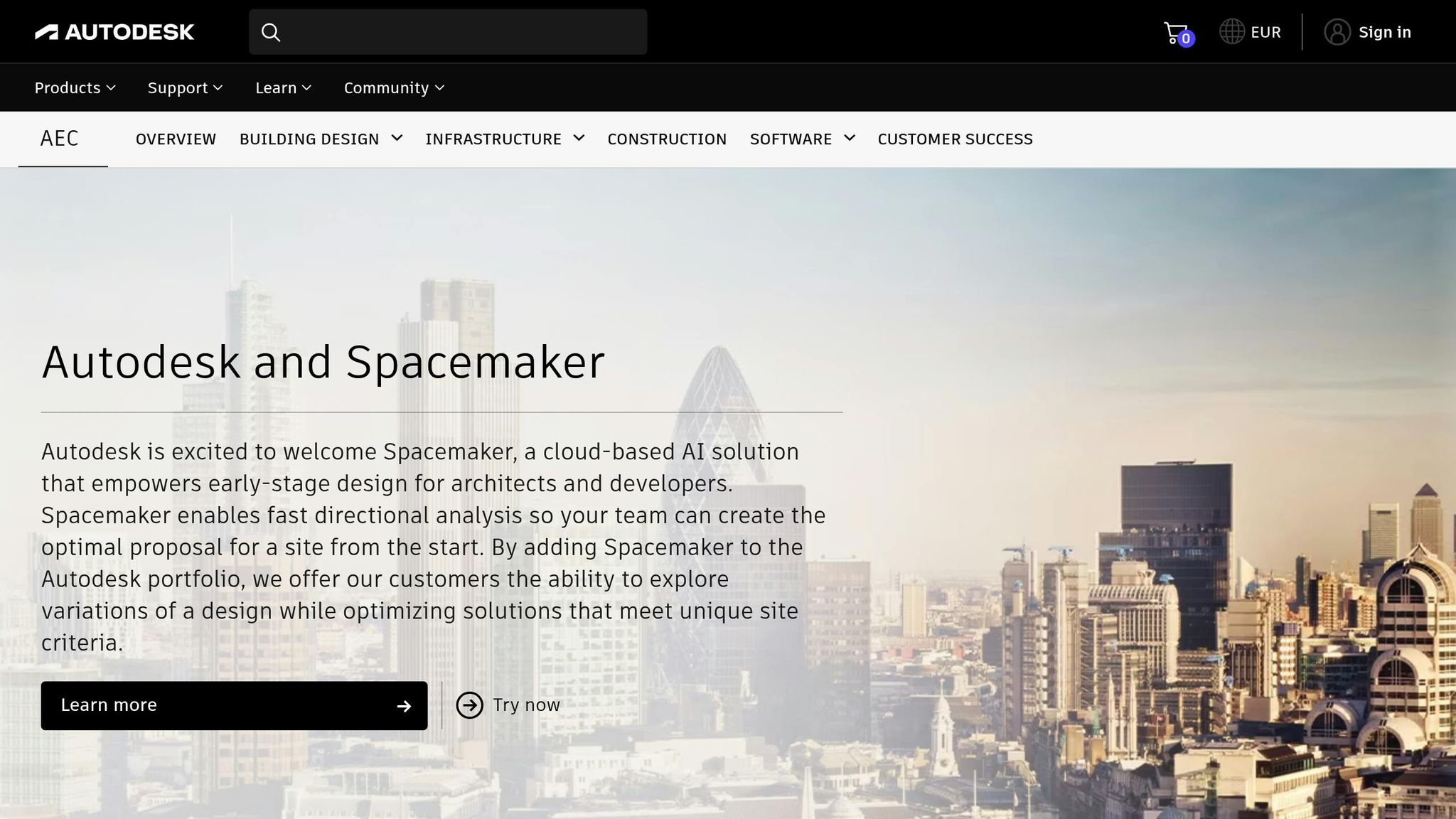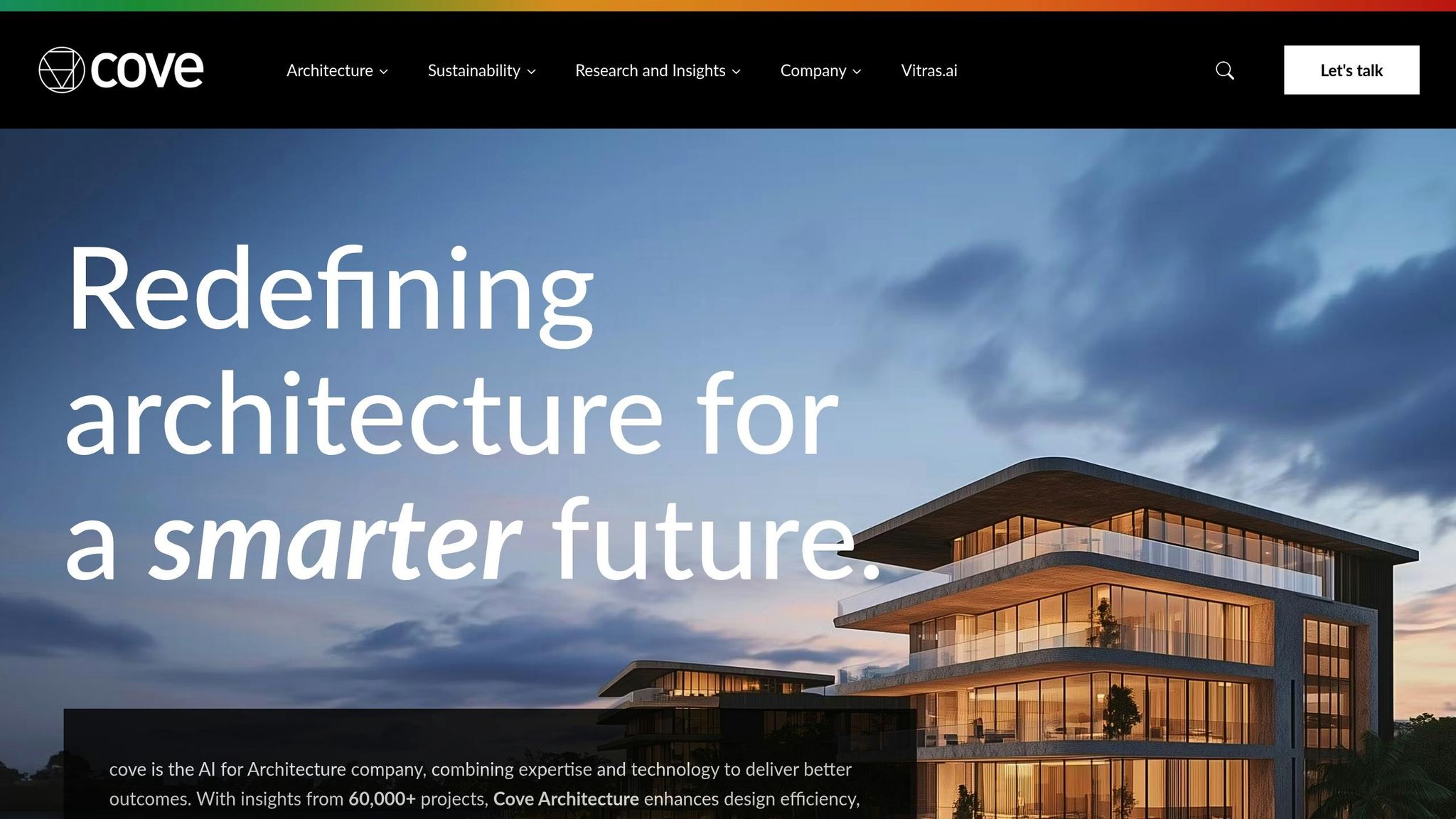AI is transforming housing design by cutting costs, speeding up timelines, and solving key challenges like affordability and sustainability. Here's how AI is reshaping the industry:
- Faster Design: Tools like qbiq and TestFit reduce design time from weeks to hours.
- Cost Savings: AI improves cost prediction accuracy (up to 97%), reduces waste, and lowers project costs by up to 20%.
- Better Space Use: Platforms like Interior AI optimize layouts for functionality and efficiency.
- Sustainability: Tools like Cove.tool help lower carbon footprints and improve energy efficiency.
- Modular Housing: AI streamlines construction, cutting building time by up to 60%.
Quick Comparison of AI Benefits in Housing Design
| Metric | Traditional | AI-Enhanced |
|---|---|---|
| Design Time | Weeks | Hours |
| Cost Prediction Accuracy | Moderate | Up to 97% |
| Material Waste | Standard | 50% reduction |
| Project Costs | Standard | 20% savings |
| Energy Efficiency | Baseline | 25% improvement |
AI tools like Spacemaker AI, TestFit, and Cove.tool are already delivering faster, cheaper, and more efficient housing solutions, addressing urgent needs like the U.S. housing shortage. However, challenges like AI bias and data reliability must be addressed to ensure fair and effective outcomes.
Main AI Technologies in Housing Design
AI is reshaping housing design by introducing advanced tools that improve efficiency, cut costs, and enhance project outcomes. These technologies are turning traditional design methods into automated, data-driven processes, streamlining tasks like space planning, project coordination, and cost management.
Space Optimization with AI
AI is revolutionizing how we utilize living spaces, making them more functional and efficient. The global AI interior design market, currently valued at $829 million, is expected to grow to $7.3 billion by 2033, with an annual growth rate of about 24%. A great example is Interior AI by Pieter Levels. This platform saw its monthly revenue jump from $5,700 in October 2022 to $45,000 by July 2023, highlighting the rising demand for AI in space optimization. These tools analyze room dimensions, suggest the best furniture arrangements, and adapt to user preferences to create tailored layouts. This focus on maximizing space is paving the way for AI-driven advancements in architectural modeling.
AI-Enhanced BIM Systems
Building Information Modeling (BIM) systems integrated with AI are setting new standards in design accuracy and project coordination. The results speak for themselves:
| Metric | Improvement |
|---|---|
| Design Clash Reduction | 75% decrease |
| Design Time | 50% reduction |
| Project Costs | 20% savings |
| Safety Incidents | 50% decrease |
| Energy Efficiency | 25% increase |
These improvements are transforming project outcomes. For instance, a New York skyscraper project used AI to analyze 150 facade options, cutting design time in half and earning LEED Platinum certification.
"Previously, with BIM software, there was more focus on the program's internal rendering capabilities, but now that has switched to ensuring that other software can plug into it." - David Lee, co-founder and CEO of FAME Architecture & Design
AI's role in cost and material planning is also making a big impact on project efficiency.
Cost and Material Planning
AI is taking cost estimation and material planning to the next level, achieving up to 97% accuracy in cost predictions. This reduces human error and helps avoid budget overruns. Tasks like construction takeoffs, which used to take hours, can now be completed in seconds, drastically improving efficiency.
Siemens’ AI-powered solution, Senseye, is a prime example of how these systems are changing the game. Factories using Senseye have reported:
- A 50% drop in unexpected equipment shutdowns
- Up to a 40% reduction in maintenance costs
- Noticeable gains in operational efficiency
These tools also help prevent over-ordering and reduce waste, cutting construction costs by up to 20% and halving material waste.
"With integrated management tools and automated procurement systems, contractors can capture and analyze material usage data in real time, allowing them to optimize orders, reduce surplus, and recycle more effectively." - buildingradar.com
Leading AI Design Platforms
AI platforms are transforming the way housing projects are designed, offering solutions that tackle challenges in cost, environmental impact, and overall design efficiency. These tools are reshaping the industry by integrating cutting-edge technology into the design process.
Spacemaker AI: Smarter Site Analysis

Spacemaker AI uses data like sunlight exposure, wind patterns, and noise levels to create optimized designs tailored to specific sites. For example, a European developer managed to save €1.9 million on a project by leveraging Spacemaker's analytics.
Here’s what Spacemaker excels at:
- Assessing environmental factors
- Streamlining master planning
- Creating early-stage design solutions
TestFit: Revolutionizing Mixed-Use Development

TestFit simplifies the planning of mixed-use developments with real-time AI configurators that significantly accelerate the design process. Developers and architects have seen impressive results with TestFit:
| Metric | Impact |
|---|---|
| Design Speed | 4-10x faster |
| Deal Closure | 92% faster completion |
| Configuration Options | Multiple typologies in one site |
| Cost Analysis | Real-time estimates |
"TestFit automates the manual process of testing development feasibility and saves us many hours of manual work. This allows us to run more scenarios and alternatives for every project. It also creates better, more accurate basic massing visuals than we can do manually." – Jamin Kimmell, Partner, Cascadia Partners
Cove.tool: Pioneering Energy Efficiency

Cove.tool focuses on sustainable building design by incorporating AI for energy modeling, carbon tracking, and performance optimization. It also ensures compliance with building codes, making the process faster and more reliable.
"The process of analyzing our building, collaborating, and creating diagrams took 2-3 weeks with [cove] instead of our typical 3 months." – Shaunt Yemenjian, Architect, Paul Halajian Architects
Key features of Cove.tool include:
- Advanced energy modeling
- Carbon footprint tracking
- Water usage optimization
- Code compliance verification
"[Cove] allows our design teams to quickly evaluate options in the early design stages that could positively impact the building's performance." – Phil Meyer, AIA, LEED AP, NCARB, Project Architect at EUA
Considering that the built environment is responsible for nearly 40% of global CO₂ emissions, these platforms are game-changers. They empower architects and developers to design housing that is not only more sustainable and cost-efficient but also quicker to produce, all while minimizing errors and maximizing potential.
AI in Coliving and Modular Housing
AI is shaking up coliving and modular housing by bringing smarter design, cutting costs, and making processes more efficient. It’s changing how these spaces are created and managed, making them more adaptable to modern living needs.
Designing Shared Living Spaces
AI is taking shared living spaces to the next level by using data to shape layouts and predict behaviors. A great example is what Enso Co-Living did in 2024. They introduced Polaroo, an AI-driven platform, to manage supply control and streamline invoice processing across 140 properties. This system handled over 2,600 invoices and saved them more than $20,000.
By analyzing layouts and predicting resident behavior, AI helps refine shared living spaces to better meet the needs of residents, foster stronger community connections, and keep operational costs in check.
Modular Housing Development
AI is also streamlining modular housing by automating construction processes and improving quality control. Atul Khanzode, Chief Technology Officer at DPR Construction, highlighted this shift:
"AI and machine learning will help automate wasteful processes, improving both productivity and project outcomes in the next five years."
The Phoenix project in West Oakland showcases this potential. Using Autodesk Forma’s AI-powered Rapid Noise Analysis, MBH Architects reduced the time for initial design packages from two weeks to just six hours. The project aims to cut construction time, costs, and carbon footprint by 50% compared to traditional multifamily housing methods.
Coliving Design Examples
Beyond improving processes, AI is transforming the resident experience in coliving spaces. Smart systems now analyze feedback to predict preferences and suggest community events that match shared interests. These features not only enhance the sense of community but also help reduce costs.
Ryan McNulty, Principal Architect at MBH Architects, highlighted the efficiency AI brings:
"Time saving is probably the biggest benefit of [AI] tools, which enable us to ensure faster delivery of much-needed housing solutions."
The impact of AI on design processes is clear, with measurable improvements like:
| Metric | Traditional Design | AI-Enhanced Design |
|---|---|---|
| Design Error Rate | Baseline | 40% reduction |
| Project Timeline | Standard | 10–15% faster |
| Labor Requirements | Standard | Up to 30% reduction |
| Building Time | Standard | Up to 60% faster |
These advancements are especially relevant as coliving continues to grow, making up 31% of flex living investments in the first half of 2023. Platforms like Coliving.com are leading the way, using AI to connect residents with flexible, all-inclusive living options.
AI Design Limitations and Ethics
AI Bias in Design
AI can be a powerful tool in housing design, but it’s not without its flaws - bias being one of the most pressing concerns. A 2022 study from the University of Southern California revealed that nearly 40% of the "facts" used by AI systems carry bias. These biases often influence decisions related to race, gender, and occupation, which can have far-reaching effects on housing accessibility and fairness.
Lisa Rice, president and CEO of the National Fair Housing Alliance, sheds light on this issue:
"These systems are still performing their originally-intended function: perpetuating disparate outcomes and generating tainted, bias-laden data that serve as the building blocks for automated systems like tenant screening selection, credit scoring, insurance underwriting, insurance rating, risk-based pricing, and digital marketing technologies. The ability of automated systems to scale can lead to, reinforce, or perpetuate discriminatory outcomes if they are not controlled."
To counter these issues, strategies like regular audits, inclusive design practices, and ongoing community input are essential. Such measures can help ensure fairness and reduce bias throughout the design process. However, addressing bias is just one piece of the puzzle - data quality is another critical factor.
Data Reliability Issues
AI’s effectiveness in housing design is only as strong as the data it relies on. With Gartner predicting that over 80% of companies will adopt generative AI in their digital workflows by 2026, the importance of reliable data cannot be overstated. Yet, challenges such as incomplete, outdated, or inconsistent datasets often undermine these systems.
One striking example comes from a 2019 University of California, Berkeley report, which found that AI-driven mortgage systems charged Black and Hispanic borrowers higher rates than White borrowers for identical loans. This highlights the urgent need for rigorous data verification processes.
Vinhcent Le, a lawyer at the Greenlining Institute, stresses the importance of oversight:
"It's great that the developers of Bob.ai decided to omit a person's name, but we can't rely on small groups of people making decisions that can essentially affect thousands. We need an agreed way to audit these systems to ensure they are integrating equity metrics in ways that don't unfairly disadvantage people."
Human Design vs AI Tools
While AI brings efficiency to housing design, it cannot replace the creativity and empathy that human designers contribute. AI excels at processing data and automating repetitive tasks, but human designers bring emotional intelligence and an understanding of cultural nuances that machines simply cannot replicate.
Conclusion: Next Steps for AI Housing Design
The next chapter in housing design is all about reshaping how we think about affordability and efficiency, using the power of AI.
Key Takeaways
AI has already made a huge impact on housing design by improving efficiency and reducing costs. Modular construction projects now finish faster and at lower expenses, with companies like Reframe Systems leading the charge through cutting-edge production techniques. The value AI brings to the housing market comes from smarter space usage, faster permit approvals, and better environmental practices throughout the design process.
These advancements are paving the way for even greater accessibility in housing.
The Future of Housing Access
Projections show the AI real estate market could hit $1,047 million by 2032, growing annually by 11.52%. This growth is already visible in projects across the country, where AI-powered design tools are delivering affordable housing solutions with improved speed and efficiency.
"By integrating AI, robotics, and localized production, we're rethinking how homes are built. Reframe's approach not only makes building faster and more affordable, but also produces homes that perform to meet the needs of today's communities", says Vikas Enti, CEO and co-founder of Reframe Systems.
Smart home technology is also evolving rapidly, blending AI with human-centered design. As Daryl Friedman, global president of CEDIA, puts it:
"AI tools in lighting will know how to utilize the location, season and time of day to automatically create the right ambiance at the right time."
For shared living spaces, AI enhances design by analyzing how communities use spaces, manage energy, and interact with their environment. This data helps developers create living areas that are not only efficient and comfortable but also affordable and community-oriented. Platforms like Coliving.com are a great example of how AI is enabling flexible, cost-effective housing options for today’s ever-changing lifestyles.
FAQs
How do AI tools like Spacemaker AI and TestFit make housing design faster and more efficient?
AI tools like Spacemaker AI and TestFit are transforming the housing design process by automating tedious tasks and speeding up decision-making. These tools can produce multiple design options in a fraction of the time, ensuring layouts are tailored to practical, real-world needs.
Spacemaker AI focuses on analyzing environmental and spatial data, helping architects design spaces that are both efficient and well-suited to their surroundings. Meanwhile, TestFit shines in conducting quick feasibility studies and site planning, making it easier to evaluate potential projects. Together, these tools allow developers and architects to deliver housing solutions more efficiently and with greater accuracy.
How are AI systems being designed to reduce bias in housing design?
AI systems in housing design are being developed with a focus on reducing bias and ensuring fairness. A major strategy involves the frequent evaluation and updating of AI models. This ensures the systems rely on current, diverse data rather than outdated or incomplete sources. By doing so, these models are better equipped to make decisions that are more representative and equitable.
Another important aspect is the use of human-centered design principles, which bring in a variety of perspectives. This approach helps make these systems more inclusive, considering the needs and experiences of different communities.
Organizations like the National Fair Housing Alliance are also making a difference. Their efforts emphasize transparency and involve stakeholders in tackling algorithmic bias in housing technologies. Together, these initiatives aim to ensure that AI tools support fair and accessible housing opportunities for all.
How is AI improving sustainability and energy efficiency in housing design?
AI is transforming housing by making it smarter and more energy-efficient. Take energy use, for instance - AI-powered systems can process real-time data from sensors to fine-tune heating, cooling, and ventilation (HVAC) systems. By adjusting these systems based on factors like occupancy and outside weather, they help cut down on energy waste and save money.
AI also has the ability to predict energy demand patterns, ensuring resources are used wisely and reducing the carbon footprint of a building. Picture modern high-rise buildings equipped with AI systems that automatically adjust energy consumption throughout the day. This not only leads to noticeable cost savings but also promotes a greener approach to housing design. The result? Homes that are not just better for the planet but also more affordable and efficient for the people living in them.






